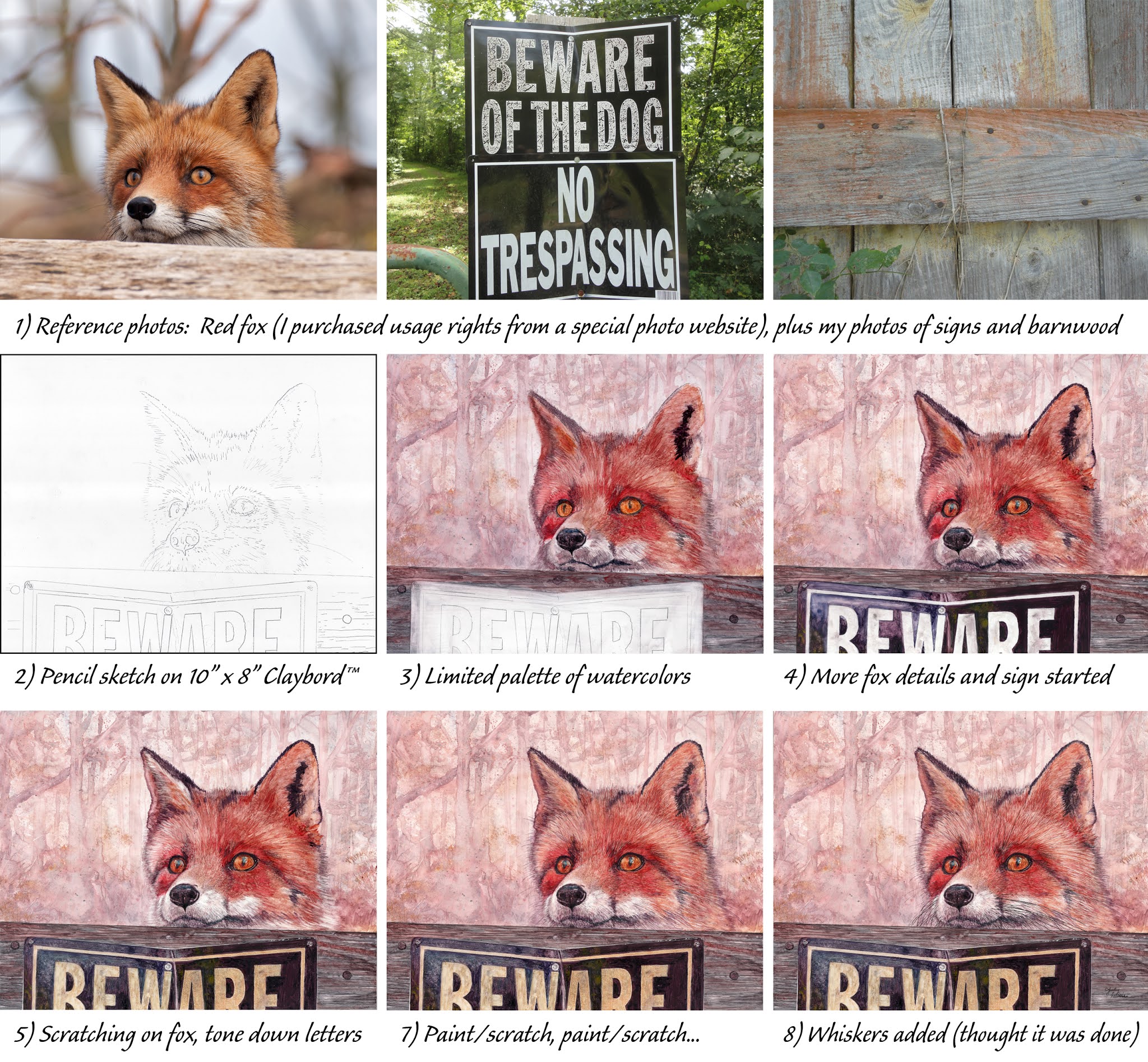"The Scratchboard technique is a two-dimensional, subtractive process. It involves the use of abrasive tools to directly remove a surface layer of one value (typically dark) to expose a second layer of a contrasting value (typically white). The values within the artwork are predominantly achieved by varying the amount of surface layer that has been scratched away or left. The texture and form of all key compositional elements within the artwork must be created by subtractive removal, not exclusively by the addition of paint or ink. Reapplying transparent mediums over the scratching is permissible, but the underlying scratches must remain visible. Works may be color or black and white."
- International Society of Scratchboard Artists
The 'purist' definition of scratchboards quoted above refers primarily to traditional black-coated scratchboarding surfaces. Judy enjoys using black scratchboards as well as white scratchboard surfaces (to which she applies color before scratching back to the original white layer). Judy picks her media and painting surfaces depending on the subject... and upon her mood.
The scratchboarding processes vary, and Judy enjoys combining her painting skills with scratching in unique ways.. She uses Ampersand™ Art museum-grade panels, which are manufactured to the highest standards. These panels are handcrafted in the US from a company which is wonderfully supportive to the arts community. Judy was hand-picked to be an Ampersand Art Ambassador in 2020. During the same year, Judy's scratchboard artwork qualified her to be accepted as a member of the prestigeous International Society of Scratchboard Artists (ISSA) in addition to having two paintings juried into their annual Exhibition in her first attempt to be chosen for this prestigeous international show. The scratchboard shown above, "I Will Twine," won 2nd Place in the ISSA's 2022 Online Exhibition in the Active Division.
HELPFUL LINKS
You can see samples of Judy's many scratchboards in her Scratchboard Gallery.
Watch Judy's "How-To" Scratchboard Videos.
Search "scratchboard" in Judy' Blog to see step-by-step scratchboarding techniques and other posts related to Judy's scratchboard artworks.
See Judy's blog post "Claybord™ 101 Resources" for details and work-in-progress photos showing how I used Claybord with nine different art media!
Judy’s Favorite Scratchboarding Surfaces (click on each tab for details)
Scratchbord™ is a rigid art panel designed for scratching and making various other abrasive marks to reveal a white layer below the black india ink surface. It is manufactured in the USA by Ampersand™ Art. Various tools and materials can be used to abrade the black surface in order to create a range of values. Sharp pointed objects, such as a #11 X-acto knife blade, are favored as scratching tools, but many other materials can be used to abrade the board, as shown in the illustration. Judy sometimes tints revealed white areas with colored paints or inks, as you can see in her Gallery of scratchboard paintings.
The Scratchbord panel has many unique properties:
- beautiful black and white artwork can be created, with dramatic effects
- lends itself well for depicting textures
- the revealed white areas can be painted with transparent colors (as shown in my painting "The Queen," shown here, to which I added transparent watercolors)
- repeated layers of scratching and coloring can help enhance the appearance of volume and dimension
- excellent surface for rendering precise details and intricate features (but not restricted to those)
- the rigid hardboard panel is archival and will not warp, tear, bend or wrinkle
- forgiving to use; repairs can be made by painting over with india ink or Ampersand Black Repair ink
- sold in many sizes as 1/8" thick panels; custom sizes can be ordered from Ampersand also
- the finished painting can be sealed with a clear UV varnish, eliminating the need for matting and glass as a conventional painting on paper requires
- sealing the finished artwork will eliminate fingerprints and hide repairs
- finished art can be left unframed and displayed on a tabletop easel, framed in an Ampersand FloaterFrame or displayed in a conventional frame profile
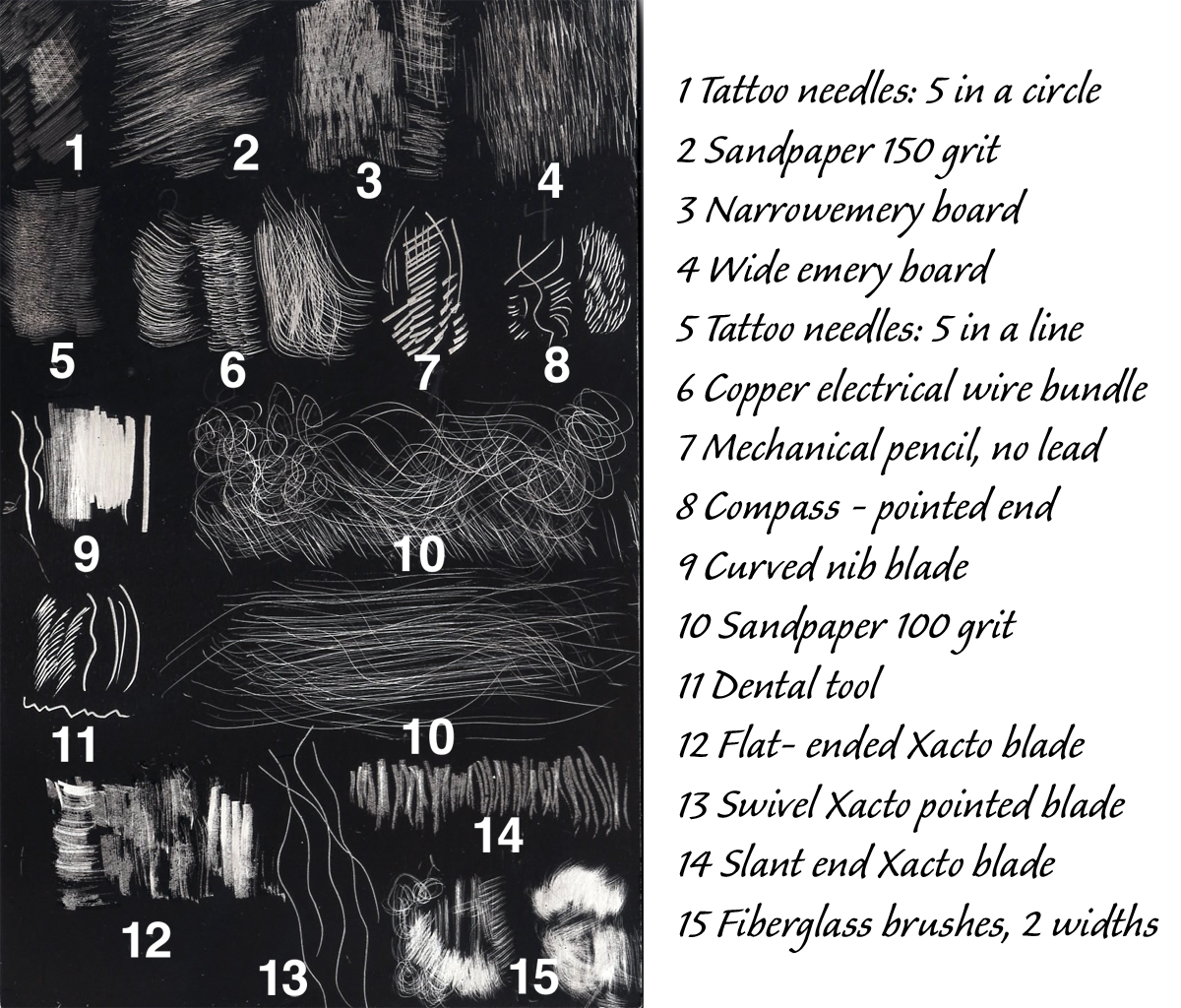

Steps in Creating “How Sweet It Is” on Scratchbord™
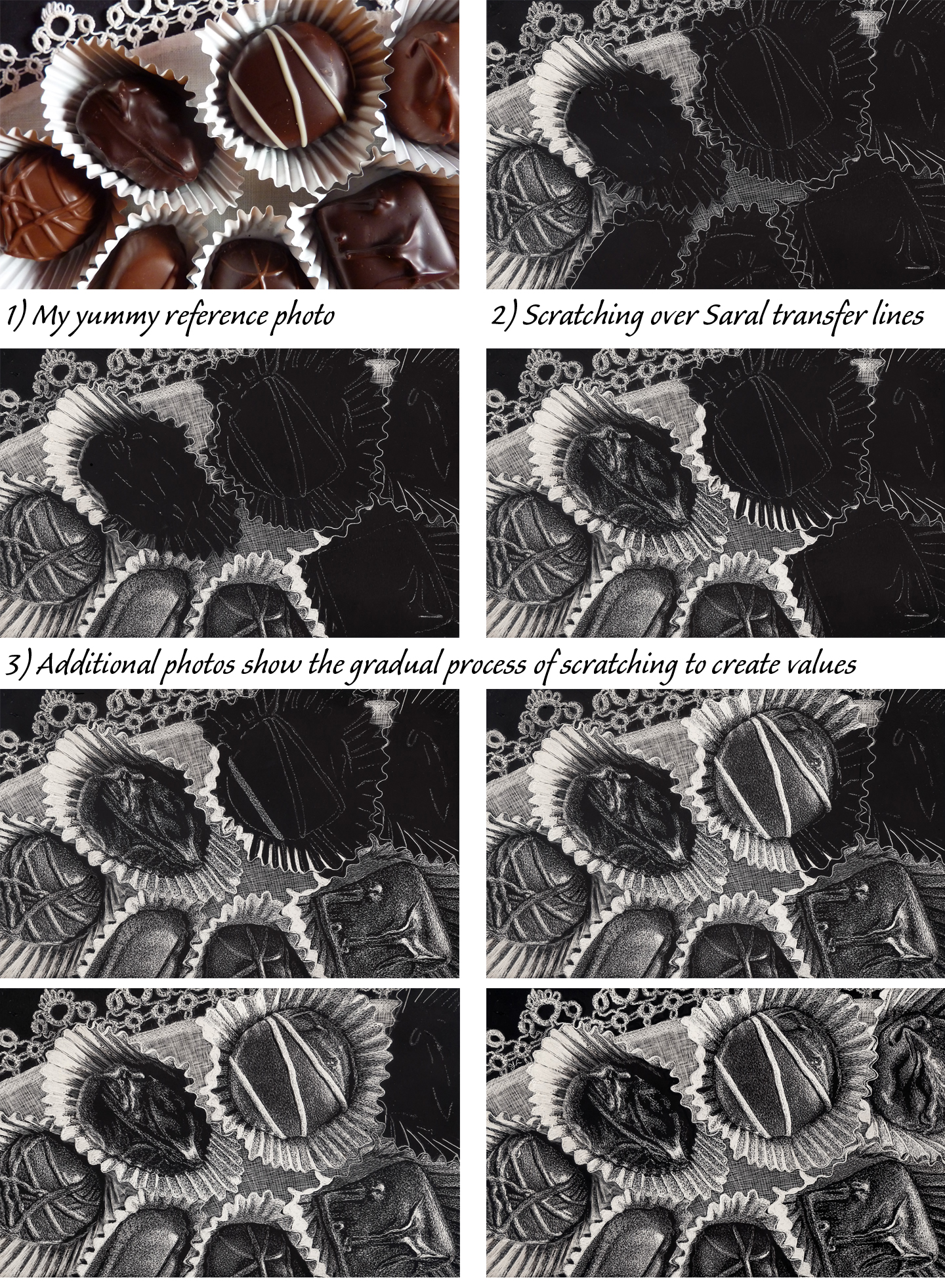
Aquabord™ is an artist panel designed for use with watercolors and other media, made by Ampersand™ Art of Texas. It is a rigid board with a slightly textured coating of fine white clay. It can be used with subtractive techniques when using water soluable pigments, as the clay layer allows lifting to remove or lighten by re-wetting the surface.
Judy uses Aquabord in a somewhat unconventional manner, using sharp and abrasive tools in a scratchboarding manner to remove the painted areas and reveal the white surface below, similar to how she uses black Scratchbord™.
The Aquabord panel has many unique properties, differing from the rough-textured ('cold pressed') heavy watercolor paper Judy most often uses for watercolor paintings:
- this surface absorbs the paint quickly, as compared with cotton watercolor papers
- the white Kaolin clay surface reflects light and makes applied colors look bright and vibrant
- can be used with watercolor, acrylic, ink, gouache, casein, colored pencils, graphite
- the clay surface allows watercolor to be re-wet and either lightened or lifted
- white areas don't need to be masked or painted around, they can be lifted or scratched away
- the entire surface can be wiped with water to lift watercolor paint off and start over (although some slight staining may occur depending on the pigments used)
- the rigid hardboard panel is archival and will not warp, tear, bend or wrinkle
- sold in many sizes as 1/8" panels, as well as cradled panels in thicknesses of 7/8", 1.5" and 2"; custom sizes can be ordered from Ampersand also
- the sides of the cradled panels can be painted, stained, waxed or otherwise finished to eliminate any need to add framing
- the finished painting can be sealed with a clear UV varnish, eliminating the need for matting and glass as a conventional painting on paper requires
- finished art can be left unframed and displayed on a tabletop easel, framed in an Ampersand FloaterFrame or displayed in a conventional frame profile
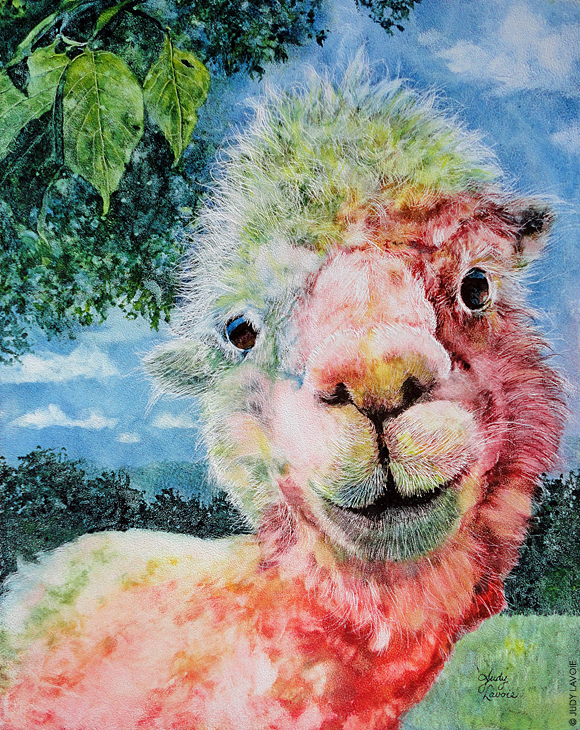
Judy’s steps in creating “Honeysuckle” on Aquabord™
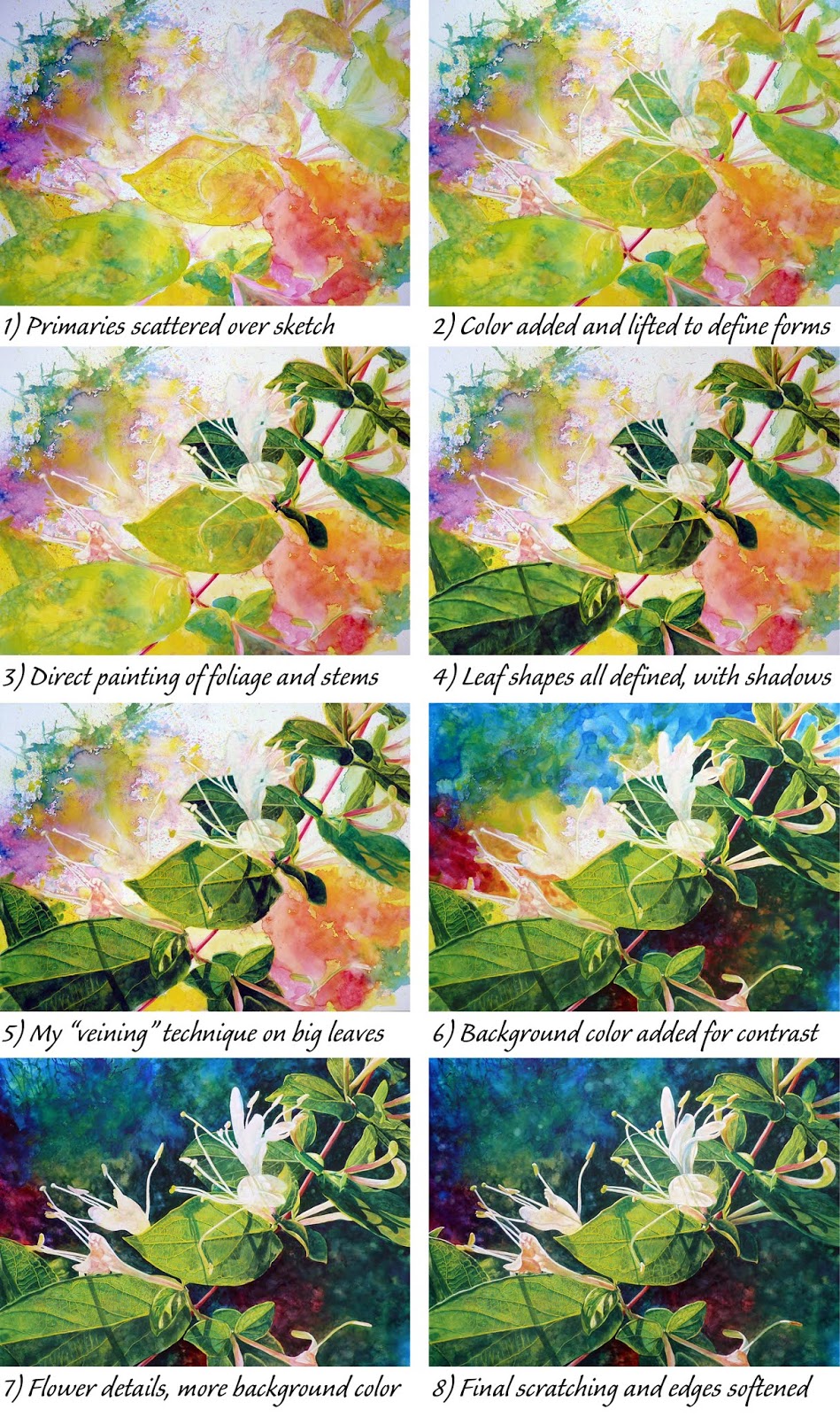
Claybord™ is a rigid art panel designed for additive and subtractive processes. Scratching and abrasive tools can be used to reveal a white layer below the surface after pigment has been applied. Claybord is made in the USA by Ampersand™ Art. It is a rigid panel with an ultrasmooth smooth white Kaolin clay surface. Watercolors on Claybord react somewhat as on hot pressed paper or Yupo, but Claybord has many other uses and other distinct properties, including:
- this surface absorbs the pigment quickly, as compared with cotton watercolor papers
- the white Kaolin clay surface reflects light and makes applied transparent colors look bright and vibrant
- can be used for artwork in watercolor, acrylic, ink, gouache, casein, colored pencils, graphite, airbrush, egg tempera, oils, as well as for different techniques such as collage, pouring, image transfers, stamping and more
- similar to chalk/gypsum gessoed panels of the Renaissance used for egg tempera and oils
- the clay surface allows watercolor pigments to be re-wet and either lightened or lifted
- white areas don't need to be masked or painted around, they can scratched away or lifted when using water soluable pigments
- repeated layers of scratching and coloring can help enhance the appearance of volume and dimension; the coating is 7 to 10 dry-mils thick, allowing for multiple cut-ins or erasers
- the entire surface can be wiped with water to lift watercolor paint off and start over; the smooth finish and the absorbency of the clay ground also allows the use of an abrasive, like oil-free steel wool or sand paper, to remove pigment without damaging the finish
- the rigid hardboard panel is archival and will not warp, tear, bend or wrinkle
- sold in many sizes as 1/8" panels, as well as cradled panels in thicknesses of 7/8", 1.5" and 2"; custom sizes can be ordered from Ampersand also
- the sides of the cradled panels can be painted, stained, waxed or otherwise finished to eliminate any need to add framing
- also sold as 'Claybord Tiles' in 5 small sizes, including standard Artist Trading Cards (ATCs) sizes - used for stamping, painting, jewelry making, collage, coasters, magnets, ornaments, scrapbooking, embellishments, and much more
- the finished painting can be sealed with a clear UV varnish, eliminating the need for matting and glass as a conventional painting on paper requires
- finished art can be left unframed and displayed on a tabletop easel, framed in an Ampersand FloaterFrame or displayed in a conventional frame profile
See my blog post "Claybord™ 101 Resources" for details and work-in-progress photos showing how I used Claybord with nine different art media!
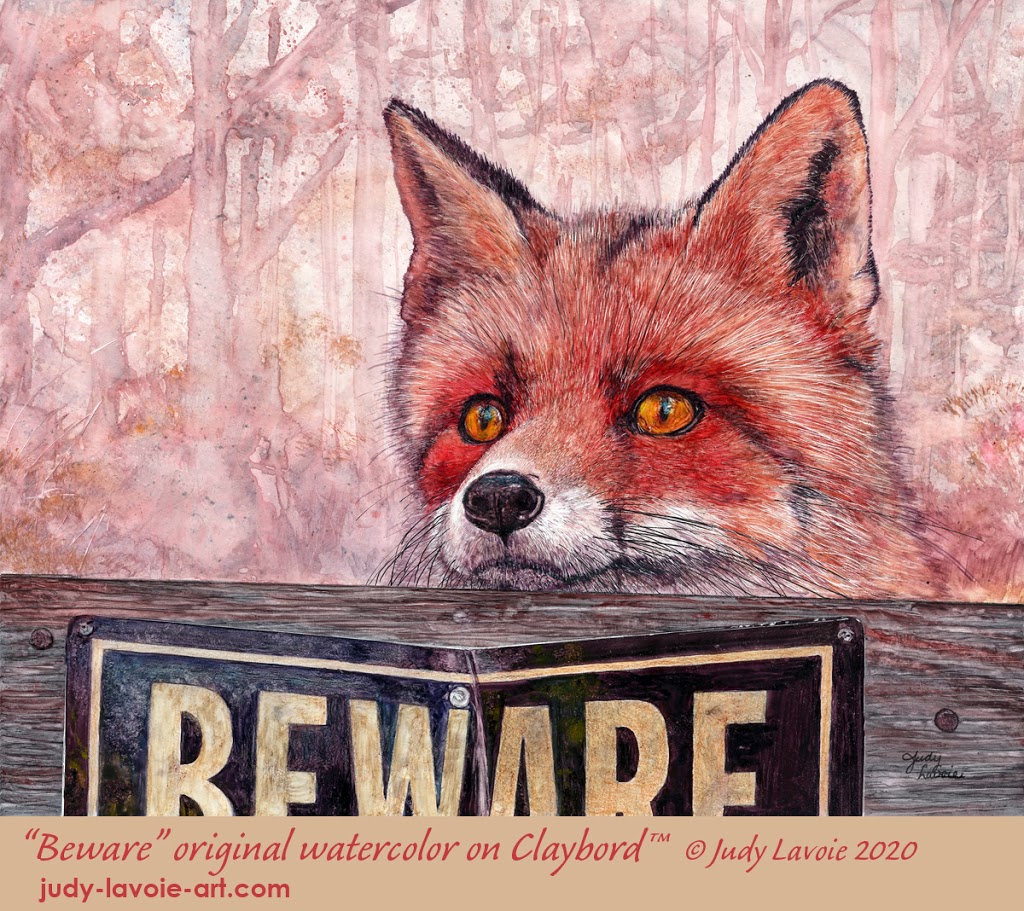

Judy’s steps in creating “Beware” on Claybord™
